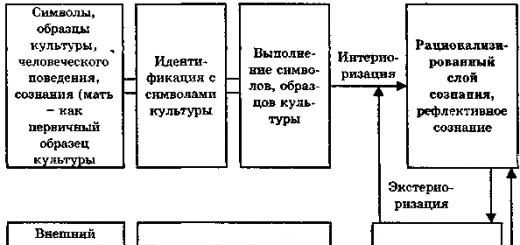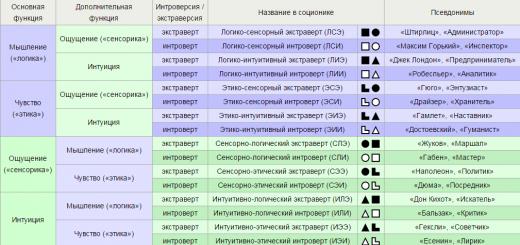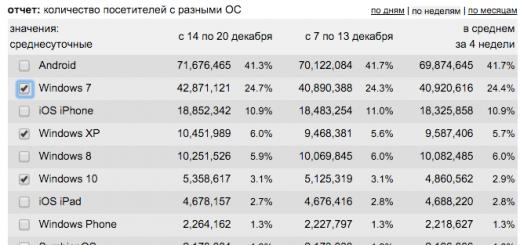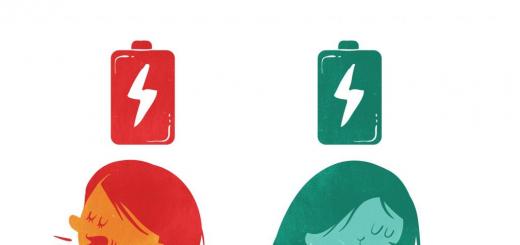1. Definition- is a minor member of the sentence, which means object attribute and answers the questions what? whose?
For example: stone(which?) house; house(which?) from stone; checkered(which?) the dress; the dress(which?) in a cage; mother's(whose?) sweater; sweater(whose?) mothers.
2. A definition always refers to a noun, a noun pronoun, or another word that takes on the meaning of a noun.
Note!
If questions which? whose? are given from the verb, then the word that answers this question is the nominal part of the predicate.
I left(which?) upset ; He was sitting(which?) tired.
3. According to the way of expression, definitions are divided into two types:
- agreed definitions;
- inconsistent definitions.
Agreed definitions agree with the main (defined) word in gender, number and case.
Wed: motherland; native land; in native lands.
In direct word order, agreed definitions come before the main word.
Ways of expressing an agreed definition
Inconsistent definitions associated with the main word with:
management- the addition is placed at the main word in a certain case.
Wed: stone house; in a stone house;
adjoining- an object is an invariable part of speech or an invariable form.
Wed: soft-boiled egg ; sideways hat; her dress.
Inconsistent definitions in direct word order are after the main word. The exception is the possessive pronouns his, her, them, which occupy a position before the main word.
Ways of expressing inconsistent definitions
| The form | Examples |
|---|---|
| 1. Noun, pronoun-noun in the indirect case with or without a preposition | Pilot flight; blouse with polka dots; lady in a hat; pleated skirt ; birch furniture; alley in front of the house; cream jar. |
| 2. Infinitive | Thirst to know; desire to see. |
| 3. Adverb | Left turn ; bulging eyes. |
| 4. Comparative adjective | Smaller trees; watermelons are riper. |
| 5. Possessive pronouns his, her, them | Her brother; their concern. |
| 6. Whole phrases with the main word - a noun | Young woman with blue eyes; tall girl; a man of great intelligence. |
4. Since inconsistent definitions can be expressed various parts speeches to which you can ask appropriate morphological questions (cf .: furniture(what? / from what?) from birch; pursuit(what? / what to do?) see; turn(what? / where?) left), sometimes it is quite difficult to distinguish between inconsistent definitions and additions, circumstances.
Ways to distinguish between inconsistent definitions and additions, circumstances
1) Many (but not all!) inconsistent definitions can be replaced by consistent definitions.
Wed: mother's jacket - mother's jacket; checkered dress - checkered dress; crystal vase - crystal vase; commander's order - commander's order; girl three years- a three-year-old girl; friendship relations - friendly relations; court decision - court decision; boat with a sail - a sailboat.
Note. Please note that it is not always possible to replace inconsistent definitions with consistent definitions ( cream jar , pleated skirt , desire to know , turn left). Therefore, the absence of a replacement does not yet indicate that this form is not a definition.
2) The definition points to the attribute, while the complement points to the object.
For example:
The man was walking with a suitcase.
I got in line for a man with a suitcase.
In the first sentence ( The man was walking with a suitcase) the addition with the suitcase refers to the verb-predicate (the definition cannot refer to the verb!) and indicates the object of the subject's action. In the second sentence ( I stood in line for a man with a suitcase) the same form with a suitcase is a definition, since "suitcase" is not an object, but a sign by which a given man can be distinguished from another man.
The same can be demonstrated with examples: lady in a hat; a man of great intelligence; polka dot blouse. The presence of a "hat" is a hallmark of a lady; the presence of a “big mind” is a hallmark of a person; the presence of "peas" on a blouse is a hallmark of a blouse.
3) If in a sentence a noun with a preposition or an adverb refers to the verb and is a circumstance, then with a noun they usually become an inconsistent definition, indicating the attribute of an object by position in space, by time, by purpose, by reason, etc.
Wed: Bench stands(where?) at home. - On the bench(which?) three girlfriends were sitting at the house; We entered(where?) to the hall. - Entrance(which?) the hall was closed.
4) The most frequent forms and meanings of inconsistent definitions are as follows:
| Meaning | way of expression | Examples |
|---|---|---|
| 1. Affiliation | sister album(cf.: album belongs to sister), brother's book(cf.: book belongs to brother). | |
| 2. Sign carrier | Noun in genitive case | The greenery of the parks(cf.: parks are green), snow whiteness(cf.: snow white). |
| 3. The content of the defined concept | Noun in genitive case | Behavior rules ; peace politics. |
| Noun in the prepositional case with the preposition o (about) | The Question of Inheritance; book of discoveries. | |
| Infinitive | Passion to contradict; desire to learn. | |
| 4. Action Producer | Noun in genitive case | Birdsong(cf.: birds sing); discovery of Columbus(cf.: Columbus discovered). |
| 5. Qualitative characteristic object (feature, property, age, measure, quantity, attribute by position in space) | Whole phrase in the genitive case | A man of great intelligence; tall man; a three year old girl. |
| Noun in the accusative case with a preposition in | Polka-dot dress ; sparkle tie. | |
| Noun in instrumental with a preposition | House with mezzanine ; boat with a sail. | |
| Noun in the prepositional case with a preposition in | Lady in a hat; man with glasses; lake in the forest. | |
| Adverb | English inscription; soft-boiled egg ; bulging eyes. | |
| 6. Material | House made of stone; cotton dress; crystal vase. | |
| 7. Origin | Noun in the genitive case with the preposition from | General of soldiers; male elder. |
| 8. The substance contained in the object | Noun in the genitive case with the preposition from under | Milk bottle; cream jar. |
| 9. Source | Noun in the genitive case with a preposition from | Dress belt; shell funnel. |
Note!
Some closely related forms:
1) The form genitive at verbal noun is a definition if it refers to the subject of the action, and an object if it refers to the object of the action.
Discovery of Columbus; Discovery of America - Columbus discovered America.
2) The form of the genitive case with the main word - a noun is a definition if the main word indicates a part of the whole, expressed by the form of the genitive case ( house wall- the wall is part of the house). The genitive form is an object if the main word indicates a container, and the genitive case indicates a substance (cf.: Cup of tea- the cup is not part of the tea; bag of potatoes- the bag is not part of the potato).The distinction between inconsistent definitions and other minor terms is important not only for parsing sentences, but also for punctuation in a sentence (!).
Definition parsing plan
- Indicate the type of definition (consistent - inconsistent).
- Specify which morphological form definition is expressed.
Sample parsing
I remember my grandmother's childhood joy at the sight of Nizhny Novgorod (M. Gorky).
childish (joy) is an agreed definition expressed by an adjective. (Joy) grandmothers- an inconsistent definition expressed by a noun in the genitive case.
1. Definition- is a minor member of the sentence, which means object attribute and answers the questions what? whose?
For example: stone(which?) house; house(which?) from stone; checkered(which?) the dress; the dress(which?) in a cage; mother's(whose?) sweater; sweater(whose?) mothers.
2. A definition always refers to a noun, a noun pronoun, or another word that takes on the meaning of a noun.
Note!
If questions which? whose? are given from the verb, then the word that answers this question is the nominal part of the predicate.
I left(which?) upset ; He was sitting(which?) tired.
3. According to the way of expression, definitions are divided into two types:
- agreed definitions;
- inconsistent definitions.
Agreed definitions agree with the main (defined) word in gender, number and case.
Wed: motherland; native land; in native lands.
In direct word order, agreed definitions come before the main word.
Ways of expressing an agreed definition
Inconsistent definitions associated with the main word with:
management- the addition is placed at the main word in a certain case.
Wed: stone house; in a stone house;
adjoining- an object is an invariable part of speech or an invariable form.
Wed: soft-boiled egg ; sideways hat; her dress.
Inconsistent definitions in direct word order are after the main word. The exception is the possessive pronouns his, her, them, which occupy a position before the main word.
Ways of expressing inconsistent definitions
| The form | Examples |
|---|---|
| 1. Noun, pronoun-noun in the indirect case with or without a preposition | Pilot flight; blouse with polka dots; lady in a hat; pleated skirt ; birch furniture; alley in front of the house; cream jar. |
| 2. Infinitive | Thirst to know; desire to see. |
| 3. Adverb | Left turn ; bulging eyes. |
| 4. Comparative adjective | Smaller trees; watermelons are riper. |
| 5. Possessive pronouns his, her, them | Her brother; their concern. |
| 6. Whole phrases with the main word - a noun | Young woman with blue eyes; tall girl; a man of great intelligence. |
4. Since inconsistent definitions can be expressed by different parts of speech, to which appropriate morphological questions can be asked (cf.: furniture(what? / from what?) from birch; pursuit(what? / what to do?) see; turn(what? / where?) left), sometimes it is quite difficult to distinguish between inconsistent definitions and additions, circumstances.
Ways to distinguish between inconsistent definitions and additions, circumstances
1) Many (but not all!) inconsistent definitions can be replaced by consistent definitions.
Wed: mother's jacket - mother's jacket; checkered dress - checkered dress; crystal vase - crystal vase; commander's order - commander's order; a three-year-old girl - a three-year-old girl; friendship relations - friendly relations; court decision - court decision; boat with a sail - a sailboat.
Note. Please note that it is not always possible to replace inconsistent definitions with consistent definitions ( cream jar , pleated skirt , desire to know , turn left). Therefore, the absence of a replacement does not yet indicate that this form is not a definition.
2) The definition points to the attribute, while the complement points to the object.
For example:
The man was walking with a suitcase.
I got in line for a man with a suitcase.
In the first sentence ( The man was walking with a suitcase) the addition with the suitcase refers to the verb-predicate (the definition cannot refer to the verb!) and indicates the object of the subject's action. In the second sentence ( I stood in line for a man with a suitcase) the same form with a suitcase is a definition, since "suitcase" is not an object, but a sign by which a given man can be distinguished from another man.
The same can be demonstrated with examples: lady in a hat; a man of great intelligence; polka dot blouse. The presence of a "hat" is a hallmark of a lady; the presence of a “big mind” is a hallmark of a person; the presence of "peas" on a blouse is a hallmark of a blouse.
3) If in a sentence a noun with a preposition or an adverb refers to the verb and is a circumstance, then with a noun they usually become an inconsistent definition, indicating the attribute of an object by position in space, by time, by purpose, by reason, etc.
Wed: Bench stands(where?) at home. - On the bench(which?) three girlfriends were sitting at the house; We entered(where?) to the hall. - Entrance(which?) the hall was closed.
4) The most frequent forms and meanings of inconsistent definitions are as follows:
| Meaning | way of expression | Examples |
|---|---|---|
| 1. Affiliation | sister album(cf.: album belongs to sister), brother's book(cf.: book belongs to brother). | |
| 2. Sign carrier | Noun in genitive case | The greenery of the parks(cf.: parks are green), snow whiteness(cf.: snow white). |
| 3. The content of the defined concept | Noun in genitive case | Behavior rules ; peace politics. |
| Noun in the prepositional case with the preposition o (about) | The Question of Inheritance; book of discoveries. | |
| Infinitive | Passion to contradict; desire to learn. | |
| 4. Action Producer | Noun in genitive case | Birdsong(cf.: birds sing); discovery of Columbus(cf.: Columbus discovered). |
| 5. Qualitative characteristics of an object (feature, property, age, measure, quantity, attribute by position in space) | Whole phrase in the genitive case | A man of great intelligence; tall man; a three year old girl. |
| Noun in the accusative case with a preposition in | Polka-dot dress ; sparkle tie. | |
| Noun in instrumental case with preposition c | House with mezzanine ; boat with a sail. | |
| Noun in the prepositional case with a preposition in | Lady in a hat; man with glasses; lake in the forest. | |
| Adverb | English inscription; soft-boiled egg ; bulging eyes. | |
| 6. Material | House made of stone; cotton dress; crystal vase. | |
| 7. Origin | Noun in the genitive case with the preposition from | General of soldiers; male elder. |
| 8. The substance contained in the object | Noun in the genitive case with the preposition from under | Milk bottle; cream jar. |
| 9. Source | Noun in the genitive case with a preposition from | Dress belt; shell funnel. |
Note!
Some closely related forms:
1) The genitive form of a verbal noun is an attribute if it indicates the subject of the action, and an object if it indicates the object of the action.
Discovery of Columbus; Discovery of America - Columbus discovered America.
2) The form of the genitive case with the main word - a noun is a definition if the main word indicates a part of the whole, expressed by the form of the genitive case ( house wall- the wall is part of the house). The genitive form is an object if the main word indicates a container, and the genitive case indicates a substance (cf.: Cup of tea- the cup is not part of the tea; bag of potatoes- the bag is not part of the potato).The distinction between inconsistent definitions and other minor members is important not only for the syntactic analysis of sentences, but also for punctuation in a sentence (!).
Definition parsing plan
- Indicate the type of definition (consistent - inconsistent).
- Indicate what morphological form the definition is expressed in.
Sample parsing
I remember my grandmother's childhood joy at the sight of Nizhny Novgorod(M. Gorky).
childish (joy) is an agreed definition expressed by an adjective. (Joy) grandmothers- an inconsistent definition expressed by a noun in the genitive case.
In Russian, it is covered in the syntax section. The definition is one of the minor members involved in the sentence; characterizes the attribute of an object, answering the questions: whose, which, what? The definition can be represented by a single word and speech construction.
Classification of definitions according to the property of syntactic connection. Condition of agreement by gender. Definitions agreed upon in number and case form. Used parts of speech
By the nature of the connection between the components of the phrase, the main types of definitions in the Russian language are distinguished: an additional type of definition is an application. The agreed definitions are expressed:
- noun that can change in numbers: fate- villainess;
- adjective: green mercedes;
- participle: unfading light;
- ordinal number: first messenger;
- pronominal adjective: my hero.
Agreed definitions take the form of the case and the number of the word, the sign of which they express. AT singular agree with the main word and gender.
as separate definitions. Isolation options for main words
A separate definition in Russian is represented by participles and adjectives. It can be isolated both intonation and punctuation in cases where:
- expressed by an adjective with a dependent word and is in postposition;
- is an participle turnover in postposition;
- several single definitions follow the main word, equipped with another prepositive definition;
- a single postpositive definition reinforces the meaning of the main word;
- distant from the word being defined by other members of the sentence;
- the definition refers to the pronoun.
Parts of speech as inconsistent definitions. What is a definition in Russian, created by the type of adjunction or control
Inconsistent definitions with the main word are connected according to the type of adjunction or control using:

Characteristics of the application and its figurative power
An application, as a kind of definition expressed by a noun, can be with the word being defined in the relationship "private - general" by the type of contiguity or agreement. This is a convenient and frequently used technique, because such a definition in Russian most figuratively conveys:
- property or quality of an object: bird- troika;
- rank, age, profession of a person: steelmaker Ivanov;
- a more accurate sign or explanation: Ural, the main landmark of the Euro-Asian border, stretched from north to south;
- names of trademarks, works of art, enterprises: a novel "Dead Souls";
- geographical names: peninsula Hindustan.
Classification of definitions according to the type of connection in the phrase. Management, coordination, connection
In a phrase, one of the following is always set:
- agreement definitions with the main word;
- control definition;
- contiguity definitions for the main word.
Communication type | Examples | Definition as a part of speech | The nature of the relationship |
Coordination | in hero cities | noun | The defined (main) word sets for its definition (dependent word) case, gender, number. |
gentle May | adjective |
||
our mothers | pronominal adjective |
||
third rider | numeral |
||
the coming age | participle |
||
Control | noun of indirect case: | The main word puts the definition in one of the cases, which remains after it in any declension of the main word. |
|
scheduled lesson, scheduled lesson | a) with a preposition (invariant with the declension of the main word) |
||
husband's brother, husband's brother, husband's brother | b) no preposition |
||
possessive pronoun: |
|||
for his misfortune, for his misfortune, for his misfortune | a) with a preposition (when the main word is declined, the preposition is replaced) |
||
her dress, her dress, her dress | b) no preposition |
||
adjoining | magazine "Crocodile", from the magazine "Crocodile" | invariable noun in the nominative case | Type of communication without external manifestations. The definition adjoins the main word in the only form that exists for it. |
Komi literature, for Komi literature | invariable adjective |
||
offhand gun, offhand gun | |||
lover to fix, to the lover to fix | infinitive |
Homogeneous definitions as a way to comprehensively characterize the attribute of the word being defined, intonation and punctuation features
Homogeneous definitions are included in the Russian language as equal words that characterize the word being defined to the same extent.

- They can refer to one attribute of the subject, which in conversation is conveyed by the intonation of enumeration.
- They can convey the gradation of a sign: close, familiar, beloved.
- If different signs are listed, homogeneity is observed according to a common criterion for all (impact on the listener, qualitative parameter):
- white, faded desert sky;
- long, straight, thick hair.
An example of preparing for a lesson in grade 6: Patterns of registration of inconsistent definitions. Repetition of the topic covered and assessment of acquired knowledge

Russian language lesson. Definition.
Topic: Regularities in the design of inconsistent definitions.
Educational goals:
- consider previously studied parts of speech as definitions;
- to form the concept of definition agreement.
Development goals:
- establish the difference between an agreed type of definition and an inconsistent one;
- stimulate creative thinking;
- develop train associative thinking.
Educational goals:
- increase applied interest in native speech;
- deepen understanding of the role of language in the history of the Russian people.
Type of lesson work: deepening the fundamental knowledge of the course.
Checking and evaluating the degree of assimilation of the previous topic:
- Indirect Complement Rule (2 people).
- Exercise 131 (1 person orally).
Repetition of grade 5 material from the "Definition" section. Acquaintance with the topic of inconsistent definitions and the rules for their design. Fizminutka for training vision - work with cards. in groups
The topic of this lesson: Patterns of registration of inconsistent definitions.

1. Indication of the goal.
2. Short review class 5 material "What is a definition in Russian":
- write phrases on the board
- mark spellings;
- indicate the method of communication;
- name parts of speech
- indicate the number and case of dependent words;
- formulate conclusions in positions:
a) definition functions;
b) differences in the type of communication;

3. Independent reading of the theoretical section.
4. Entering the topic in a notebook: "Methods of registration of inconsistent definitions".
5. Retelling the rule.
6. Removing eye strain - showing cards. Definition in Russian: guidance questions.

Questioning and performing exercises in order to consolidate new material. Work in groups, acquaintance with texts of different levels of complexity
Fixing new material:
- formation of agreed and inconsistent phrases (orally 4 people);
- write out the indicated phrases on the board, indicating the type of definition (1 person);
- give examples of definitions with an explanation of their role in the conversation.
Group work:
| I | School Description. |
| II | “It is a thousand times preferable to have common sense without an education than to have an education and be deprived of common sense". R.G. Ingersoll |
| III | School, medical..na, ol..garh, leader..rstvo, s..knowledge, r..pport, j..nathan, p..esa, tel..graph, erudite..I, bra.. stvo, enlightenment, sh..colad, impression..smoldering, most..nstvo, zoo..chiy, mit..ng, march(?)stvovat, h..mpion, k..comfort. |
| IV | "The most equipped classroom in the school." |
| V | “During trial testing, Lena tried to use a cheat sheet. The teacher noticed this and rated the result of her testing for a deuce. How to explain to the teacher and do I need to tell my parents about this? |
| VI | “It is unlikely that a negligent student will want to understand the role of a definition in Russian, who can write even a simple dictation with so many mistakes and corrections that the red marks of a teacher’s pen will sparkle in his eyes. Without the hard work of thought without the development of skills, attending classes will be meaningless. |
distribution of texts. The general task is to highlight the definitions. Additional tasks
| Groups | Creative task | Analytical task |
| I | Write on your behalf. | Designate definitions. |
| II | Rewrite the sentence with commas. | Provide arguments. Highlight definitions. |
| III | Write out the words in the context of "education". | Describe this connection using the selected words as an example. Write phrases with these words. Highlight definitions. |
| IV | Describe your impression. | Extract definitions. |
| V | Clarify the situation. | Describe possible actions. Highlight definitions. |
| VI | Perform a punctuation check. | Write out phrases with an agreed definition. |
Final concepts: what is a definition in Russian; methods of marking inconsistent definitions. Homework

- Learn the rules for marking inconsistent definitions.
- Write down 5 phraseological units from the life of birds.
- Exercises to prepare for dictation.
- Exercise on the topic.
The inconsistent definition often causes punctuation difficulties. The difficulty lies in the fact that it is not always easy to distinguish it from the agreed one, which will be separated by a comma. It is difficult to find a good text that does not contain these sentence members, because their use enriches speech. However, agreed and inconsistent definitions, examples of which are presented below, are an attribute only of written speech.
Secondary members of the sentence explain the main ones, but can also refer to the same minor ones. If they complement the grammatical basis, they will be called secondary members of the subject or predicate group.
For example:
The high, cloudless sky completely occupied the horizon.
The subject is the sky. Its group: the definitions are high, cloudless. The predicate - occupied. His group: addition horizon, circumstance completely.
Definition, addition, circumstance - these are the three minor members of the sentence. To determine which of them is used in a sentence, you need to ask a question and determine the part of speech. So, additions are most often nouns or pronouns in indirect cases. Definitions - adjectives and parts of speech close to them (pronouns, participles, ordinal numbers, also nouns). Circumstances are adverbs or participles, as well as nouns.
Sometimes there is a polysemy of the secondary term: it answers two questions at the same time. As an example, consider the sentence:
The train to Omsk left without delay.
The secondary member to Omsk can act as a circumstance (train (where?) to Omsk) or as a definition (train (what?) to Omsk).
Another example:
Snow lies on spruce paws.
The secondary member on the paws is both a circumstance (lies (where?) on the paws) and an addition (lies (on what?) on the paws).
What is definition
Definition - such a secondary member of the sentence, to which you can ask questions: “What?”, “What?”, “What?”, “What?”, “Whose?”
Distinguish agreed and inconsistent definitions. Gradation depends on how this member of the sentence is expressed.
A definition can be an adjective, a noun, a numeral, a pronoun, a participle, and even an infinitive. They extend the subject, object, and circumstance.

For example:
The last leaves hung from the frozen branches.
The definition of the latter refers to the subject leaflets; the definition of frozen refers to the addition-circumstance on the branches.
Sometimes these minor members of the sentence can carry the main semantic load of the subject and be included in its composition.
For example:
A villager does not like to get out into a stuffy city.
Here the role of the definition village is very interesting, without which the subject inhabitant would not make sense. That is why it will be part of the main member of the proposal. Thus, in this example, the subject is a villager.
Semantic functions of definitions
Both agreed and non-agreed definitions can express the following meanings:
- The quality of the item (beautiful dress, interesting book).
- Quality of action (opened door, thinking student).
- Place (forest fire - fire in the forest).
- Time (December holidays - holidays in December).
- Attitude to another object (clay vase - clay vase).
- Belonging (mother's heart - mother's heart).
Agreed Definition
Definitions agreed can act as the following parts of speech:
- Adjective name (children's toy, deep lake).
- Pronoun (your car, a certain amount).
- Communion (meowing kitten, waving flag).
- Numerals (eighteenth fighter, first student).
Between this definition and the word to which it refers, there is an agreement in gender, number and case.

Our majestic history spans twenty centuries.
Here are the following agreed definitions:
History (whose?) Ours - pronoun;
History (what?) majestic - adjective;
Centuries (how many?) Twenty - numeral.
As a rule, the agreed definition in the sentence is before the word to which it refers.
Definition inconsistent
Another, more expressive kind is the inconsistent definition. They can be the following parts of speech:
1. Nouns with or without a preposition.
2. Adjectives in the comparative degree.
3. Verb-infinitive.
Let's analyze a sentence with an inconsistent definition:
The meeting with classmates will take place on Friday.
Meeting (what?) With classmates. An inconsistent definition with classmates is expressed by a noun with a preposition.
Next example:
I have never met a friendlier person than you.
The inconsistent definition is expressed by the comparative degree of the adjective: a person (which one?) Is more friendly.
Let's analyze the sentence, where the definition is expressed by the infinitive:
I had a great opportunity to come to the seashore every morning.
There was an opportunity (what?) to come - this is an inconsistent definition.

The examples of sentences discussed above allow us to conclude that this type of definition is most often found after the word to which it refers.
How to distinguish an agreed definition from a non-agreed one
In order not to get confused about which definition is in the sentence, you can follow the algorithm:
- Find out what part of speech the definition is.
- Look at the type of connection between the definition and the word to which it refers (agreement - an agreed definition, control and adjacency - an inconsistent definition). Examples: meowing kitten - connection agreement, definition meowing - agreed; a box made of wood - communication control, the definition of wood is inconsistent.
- Pay attention to where the definition is in relation to the main word. Most often, the main word is preceded by an agreed definition, and after it, an inconsistent definition. Examples: a meeting (what?) with investors - the definition is inconsistent, it is after the main word; deep ravine - the definition is agreed, it stands after the main word.
- If the definition is expressed sustainable combination or a phraseological turn, it will certainly be inconsistent: she was (what?) neither fish nor meat. Phraseologism neither fish nor meat acts as an inconsistent definition.

A table will help distinguish between agreed and inconsistent definitions.
Parameter | Agreed | inconsistent |
What is expressed | 1. Adjective. 2. Pronoun. 3. Communion. 4. Numerals. | 1. Noun with or without a preposition. 2. Infinitive. 3. Adverb. 4. Comparative adjective. 5. Pronoun. 6. Indivisible combination, phraseological unit. |
Communication type | Agreement in gender, number and case | 1. Management. 2. Connection. |
Position | Before main word | After the main word |
The concept of isolation
Situations often arise when in a sentence there are separate agreed and inconsistent definitions that require selection by appropriate punctuation marks (commas or dashes). Separation always implies two identical punctuation marks, it should not be confused, for example, with commas when homogeneous members where single commas are used. In addition, the use of two different characters in isolation is a gross mistake, which indicates a misunderstanding of this linguistic phenomenon.
Separating agreed definitions with commas is a more frequent phenomenon than separating inconsistent ones. To determine whether a comma is necessary, you need to pay attention to two aspects:

- The position of a separate definition in relation to the word being defined.
- How are the members of the sentence participating in the isolation expressed (the definition itself and the word being defined): history (what?) majestic - adjective; centuries (how many?) twenty - numeral.
Separation of agreed definitions
If the agreed definition is after the word being defined, it must be separated by commas if:
- It is a participle. For example: A basket of mushrooms, collected the day before, stood in the cellar. Here, the isolated definition collected the day before is a participle turnover, which is located after the word basket being defined.
- It is an adjective with dependent words. For example: Through the glass, crystal clear, you could see everything that was happening in the yard. Here, the definition of crystal clear is an adjective (pure) and its dependent word (crystal). It is required to put commas, because this revolution is located after the word glass, which is being defined.
- Definitions are necessarily separated if there is another definition before the word being defined. For example: Autumn days, bright and sunny, soon faded away. The definition of autumn is in front of the defined word days, respectively, the definition of bright and sunny must be separated by commas.
- Definitions are not common, they are in the sentence after the word being defined. For example: The southern night, black and warm, was full of mysterious sounds. The definition black and warm are two uncommon adjectives connected by the union and. There may be such an option: the southern night, black, warm, was full of mysterious sounds. In this example, the union is absent, but the definition is still isolated.
In the latter case, you need to be more careful, because there are situations when the definition is closely related in meaning to the word to which it refers, so it is not required to separate it with commas. For example:
In a country far from home, loneliness is somehow felt in a special way.
The definition far from home should not be separated by commas, because without it the meaning of the sentence is not clear.
Separation of the agreed definition, which is before the word being defined, is necessary if it has the meaning of cause or concession. For example:
Exhausted by the difficult transition, the tourists were glad to set up camp.
In this case, the definition of exhausted long walk is isolated because it is used in the sense of a reason: since the tourists were exhausted by a difficult transition, they were glad to set up camp. Another example:
Not yet landscaped, the trees are elegant and festive.
Here the definition has a concession that has not yet been planted with greenery: despite the fact that the trees have not yet been planted with greenery, they are elegant and festive.
Separation of inconsistent definitions
Separate inconsistent definitions are a rather rare phenomenon. Usually they are paired with matched ones. Thus, isolated inconsistent definitions are usually used after the word being defined and are associated with the agreed connection by agreement.
For example:
This coat, new, ribbed, suited Natasha very well.
In this example, the inconsistent ribbed definition is related to the agreed new definition, so it needs to be isolated.
Here is another sentence with a separate, inconsistent definition:
Quite by accident we met Andrey, in the dust, tired.
In this case, the inconsistent definition in the dust is related to the consistent definition of tired, so commas are required.
It is not necessary to separate with commas the cases when there are isolated inconsistent definitions before the agreed one. Examples:
From a distance we saw sailors in pressed uniforms, happy and contented.
In this case, it is possible not to isolate the inconsistent definition in a smoothed form, because after it there are agreed: happy, satisfied.
In classical literature, one can find both non-isolated and isolated inconsistent definitions. Examples:
Two stearin candles, in travel silver chandeliers, burned in front of him. (Turgenev I.S.) and Three soldiers in overcoats, with guns on their shoulders, walked in step to replace the company box (Tolstoy L.N.).
In a sentence from Turgenev's work, the inconsistent definition in travel silver chandeliers is isolated, but Tolstoy's sentence of the same construction is not. In the latter there are no punctuation marks in the definitions in overcoats, with guns.
As a rule, inconsistent definitions related to the predicate group are not isolated. Let's look at the last example: they walked (how? in what?) with guns, in overcoats.
Application as a special kind of definition
A special kind of definition is an application. It is always expressed by a noun. Applications and inconsistent definitions should be distinguished. The latter are associated with the word being defined by means of control, while between the application and the main word there is an agreement.
For example, let's compare two sentences:
1. You, as the chief engineer, must oversee this project.
2. This woman in a white coat made the guys grumble.
In the first case, we have an application engineer. Let us prove this by declining the main and the definition of the word. You are an engineer - you are an engineer - you are an engineer - you are an engineer, etc. The connection between the words is clearly visible agreement, respectively, we have an application. Let's try to do the same with the definition from the second sentence. A woman in a white coat - a woman in a white coat - a woman in a white coat. Communication is control, so here we observe an inconsistent definition.
In addition, the application simply names the subject differently, while the inconsistent definition is some kind of its sign.
Application isolation
A single application, as a rule, is written with a hyphen: hostess sister, lord commander. In certain cases, the application will stand apart. Let's sort them out.

The application that refers to the personal pronoun is separated. Examples:
1. Does she, an excellent student, take care of the control.
Here the application of an excellent student refers to the pronoun to her.
2. Here it is, the reason.
We isolate the application reason, because it refers to the pronoun she.
A common application is isolated if it is located after the word being defined. Examples:
1. A brave captain, a thunderstorm of the seas, easily passed any reefs.
The thunderstorm application is a common one (thunderstorm (what?) of the seas), so you need to separate it with commas.
2. The girl, everyone's favorite, received the best gift.
The application universal favorite is used after the word girl being defined.
Applications are separated with the meaning of reason, concession, clarification (with it there is a union like). Example:
You, as an investor, can control the work of employees. - You can control the work of subordinates because you are an investor (reason value).
Here you need to be careful, because the application with the union as in the meaning of "as" is not isolated. For example:
As a school discipline, mathematics develops logical thinking well. - As school discipline mathematics develops logical thinking well. Separation is not needed.
If a standalone application located at the end of a sentence - it can be distinguished with a dash. For example:
The rest of the sisters are similar to each other - Elizabeth and Sophia.
The application Elizabeth and Sophia is at the end of the sentence, so a dash is separated.
§1. General concepts
Secondary members of the proposal are not included in grammatical basis. They spread the main and other minor members, contain the components of meaning needed for a more detailed transmission of information. Compare:
The boy is eating.
(information is presented without details)
The little boy eats the soup slowly.
(information presented in more detail thanks to minor members)
Minor Members:
- addition,
- definition,
- circumstance.
§2. Addition
Addition- this is a minor member of the sentence, which depends on the predicate (or other members of the sentence) and answers the questions of indirect cases. For example:
I love (what?) ice cream.
(addition: ice cream)
How is the complement expressed?
1. A noun in indirect cases without a preposition or with prepositions:
We met with Anna on the square. I gave her flowers.
2. In addition to the nouns themselves, the expression of the addition of words in the function of the noun is common: adjectives and participles formed by the transition to another part of speech, for example: sick, in love, participating, meeting, etc.:
The old man looked at the young with a smile.
3. Numeral name:
Ten is divisible by two.
4. Both nouns and words in the function of nouns can be replaced by the corresponding pronouns:
The old man looked at them with a smile.
5. Verb:
The doctor advised him to walk a lot.
6. As an addition, syntactically indivisible phrases or stable lexical combinations (=phraseological units) can act:
We have read several books.
(some books- syntactically indivisible phrase, it is impossible to say: We read books. Or: We have read some)
We ate a pound of salt together.
(a pood of salt- phraseology)
One must distinguish between direct and indirect addition.
Direct and indirect object
direct complement- this is an addition in the form of V.p. without a suggestion. It refers to a verb and is used after transitive verbs:
I wash my hands.
A direct object can also be in the form of R.p., if:
- a part of an object is indicated, a certain amount, for example, a little: drink water, eat soup;
- with a transitive verb there is a negation not:did not build a new building, did not complete homework.
All other cases of complement are called indirect complement.
§3. Definition. Agreed and inconsistent definition. Appendix
A definition is a minor member of a sentence, which depends on the subject, complement or circumstance, determines the attribute of the subject and answers the questions: which one? which? whose?
The definition can refer to words of different parts of speech: a noun and words formed from adjectives or participles by transition to another part of speech, as well as pronouns.
Agreed and inconsistent definition
Agreed Definition is a definition for which the type of syntactic connection between the main and dependent words is agreement. For example:
A disgruntled girl was eating chocolate ice cream on the outdoor terrace.
(girl(which?) dissatisfied, ice cream(which?) chocolate, on the terrace(which?) open)
Agreed definitions are expressed by adjectives that agree with the defined words - nouns in gender, number and case.
The agreed definitions are expressed:
1) adjectives: dear mother, beloved grandmother;
2) participles: a laughing boy, a bored girl;
3) pronouns: my book, this boy;
4) ordinal numbers: the first of September, by the eighth of March.
But the definition can be inconsistent. This is the name of a definition associated with the word being defined by other types of syntactic connection:
- management
- adjoining
Inconsistent definition based on control:
Mom's book was on the bedside table.
Wed: mom's book mom's book
(mother'sbook is the agreed definition, the link type is agreement, and mom's book- inconsistent, communication type - control)
Inconsistent adjacency-based definition:
I want to buy her a more expensive gift.
Wed: more expensive gift - giftexpensive
(more expensive gift- inconsistent definition, connection type - adjacency, and gift dear
Inconsistent definitions also include definitions expressed by syntactically indivisible phrases and phraseological units.
Opposite lined up shopping center five floors.
Wed: five-story center - five-story center
(center on five floors is an inconsistent definition, the link type is control, and five-storey center- agreed definition, type of connection - agreement)
A girl with blue hair entered the room.
(girl with blue hair- inconsistent definition, link type - control.)
Different parts of speech can act as an inconsistent definition:
1) noun:
The bus stop has been moved.
(bus- noun)
2) adverb:
Grandma cooked the meat in French.
(in French- adverb)
3) a verb in an indefinite form:
She had the ability to listen.
(listen- verb in indefinite form)
4) comparative adjective:
He always chooses the easier path, and she chooses the harder tasks.
(easier, harder comparative degree of adjectives)
5) pronoun:
Her story touched me.
(her- possessive pronoun)
6) syntactically indivisible phrase
Application
Application is a special kind of definition. An application is a definition expressed by a noun that agrees with the word being defined in the case.
Applications denote various features of an object that are expressed by a noun: age, nationality, profession, etc.:
I love my little sister.
A group of Japanese tourists lived with me in the hotel.
A variation of the application are geographical names, names of enterprises, organizations, press organs, works of art. The latter form inconsistent applications. Compare examples:
I saw the embankment of the Sukhona River.
(Sukhony- agreed application, words rivers and Sukhony stand in one case.)
The son read the fairy tale "Cinderella".
("Cinderella"- inconsistent application, words fairy tale and "Cinderella" stand in different cases
§4. Circumstance
Circumstance- this is a minor member of the sentence, denoting a sign of action or another sign. Usually the circumstance depends on the predicate.
Since the meanings of circumstances are diverse, the circumstances are classified according to their meaning. Each meaning has its own questions.
Circumstance ranks by value
The following categories of circumstances are distinguished by value.
- Mode of action - how? how?: The children laughed out loud.
- Measures and degrees - how? to what extent?: We are tired to the point of exhaustion.
- Places - where? where? from where?: Everyone around was dancing. He looked into the distance. Father returned from work.
- Time - when? how long? since when? How long? what time?: We waited for the doctor's appointment for about ten minutes.
- Conditions - under what condition?: If desired, everyone can learn better.
- Reasons - why? why?: Masha missed classes due to illness. We didn't go to the forest because of the rain.
- Goals - why? for what?: She came to Yalta to rest.
- Concessions - in spite of what? in spite of what?: Despite the fatigue, the mother was cheerful.
Circumstances are expressed
1) adverbs: fast, loud, fun;
2) nouns in the form of indirect cases with and without a preposition: in the forest, by Tuesday, a week;
3) pronouns: in it, above it, below it;
4) gerunds and participle turns: lying on the stove, you will not meet good luck;
5) indefinite form of the verb: I came to talk;
6) phraseological turn: he worked carelessly;
7) the circumstances of the mode of action are expressed comparative turnovers: Quartz sand sparkled like February snow in the sun.
test of strength
Find out how you understood the contents of this chapter.
Final test
Are the secondary members of the sentence included in the grammatical basis of the sentence?
Is it true that the minor members of the sentence spread the main and other minor members?
What are the secondary members of the sentence in Russian?
- predicate and circumstance
- circumstance, definition and subject
- addition, definition and circumstance
Can the complement be expressed as a numeral?
Is it true that an indirect object is an addition in the form of V.p. no suggestion?
What is the name of the definition for which the type of syntactic connection between the main and dependent word is agreement?
- agreed definition
- inconsistent definition
What is the definition in the sentence: This is dad's jacket.?
- agreed definition
- inconsistent definition
What type of syntactic connection in the phrase more expensive gift in a sentence: I want to buy a more expensive gift.?
- agreement
- control
- contiguity










